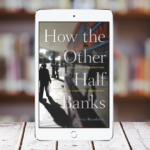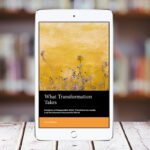Introduction
Poverty, by America makes the case for changing how we conceptualize and understand poverty by drawing on extensive research from various fields including policy, economics, and sociology, in addition to Desmond’s own anecdotal experiences. The persuasive power of the work emerges through an eloquent combination of logical, evidence-based arguments and strategic doses of empathy that guide us to Desmond’s unwavering conclusion about why poverty persists: our own responsibility.
For those of us engaged with addressing complex questions, Poverty, by America has much to teach us as an exercise of asking a broad, thorny question and using evidence and experience to answer it with a simple answer—though one that might feel hard to swallow.
In this review, I summarize Desmond’s explanation for poverty in America and what he presents as the solution, while highlighting examples of the evidence he uses. I also share my reflections on how Desmond navigates the ways we deflect the conversation he wants to have about poverty in America.
How do we sponsor American poverty?
Exploitation
Corporate practices for exploiting workers include just-in-time scheduling, preferences for contracts over employment, and rules against discussing salary or unionizing. Desmond cites an analysis published in Harvard Law Review estimated that the median income would rise by at least a third if we had a perfectly competitive labor market (Pg 57).
In the housing market, forces constrain choice for poor Americans on all sides: rising costs of rent, housing discrimination, lack of access to mortgages, and homeowners’ efforts to make housing in their neighborhoods “scarce and expensive” (Pg 120). As a signal of exploitation, Desmond & Wilmers, 2019 analysis of the Rental Housing Finance Survey revealed that average landlord earnings per unit in poor neighborhoods ($300) exceed those in rich neighborhoods ($250) (Pg 66).
While we often imagine that the financial market has forgotten or left behind the poor, Desmond tells a story of willful exclusion and exploitation. He highlights two figures: $9.8 billion in payday loan fees and $11 billion in overdraft fees per year. Banks’ history of discrimination against Black customers and lack of interest in opening branches in poor neighborhoods created a vacuum that the payday loan industry fills, extracting billions in fees from low-income workers (Pg 77). Meanwhile, within the traditional banking sector, 9 percent of account holders – those who carry an average balance of less than $350 – pay 84 percent of overdraft fees (Pg 71). This reality of vastly different banking systems and experiences is discussed in another R&E Search for Evidence post by Ebelechukwu Monye, reviewing How the other half banks: Exclusion, exploitation and the threat to democracy.
Lopsided welfare state
Next, Desmond argues that our welfare state favors wealthier Americans. While political rhetoric bemoans poor Americans’ welfare dependency, the evidence suggests the opposite: poor Americans tend to leave available aid on the table. Unused aid adds up to nearly $142 billion per year, just accounting for food stamps, government health insurance, unemployment insurance when between jobs, and Supplemental Security (Pg 89-90).
On the flipside, Desmond observes that affluent families benefit most from federal aid, such as tax breaks on employer-sponsored health insurance, mortgage interest deductions, and 529 plans (Pg 93). In all, “the top 20 percent of income earners receives six times what the bottom 20 percent receives in tax breaks” (Pg 101).In a nutshell, while the wealthy pay more taxes in absolute terms, the regressive nature of other taxes offset progressive tax structures.
Segregation and bifurcation
He finds evidence of this segregation in zoning laws: in many cities, 75 percent of residential land is reserved for detached single-family homes (Pg 114). Looking at education, he finds today’s children attend schools that are less economically diverse than their grandparents’ schools (Pg 165). He also looks to our own lived experience: “A pricey mortgage doesn’t just buy a home; it also buys a good education, a well-run soccer league, and public safety so thick and expected it appears natural, instead of the product of social design” (Pg 112).
Desmond suggests we interpret our society not as broken, but as bifurcated. Our lived experience differs starkly from that of the poor, whether geographically, in the financial services we use, or in the housing and labor markets available to us. Desmond observes, “the duality of American life can make it difficult for some of us who benefit from the current arrangement to remember that the poor are exploited” (Pg 78).
“Broken” does not describe a system that consistently advantages those with privilege. More aptly, our bifurcated systems produce different results for different groups.
The solution
First, rebalance the social safety net to be a cure, not a band-aid, for poverty. We need to strengthen tax enforcement, ensure that low-income Americans receive the aid for which they qualify, and raise the corporate tax rate, which is at an eighty-year low (Pg 127). Second, cut exploitation to empower the poor. Create choice by reducing barriers for workers to organize, expanding housing opportunities for low-income families, ensuring fair access to capital, protecting reproductive choice, and more. Third, desegregate to create a new, shared prosperity. We need to replace exclusionary zoning with more inclusive policies.
The least we can do, Desmond says, is to be honest: “If this is our design, our social contract, then we should at least own up to it” (Pg 102). The claim that we cannot afford to help, he argues, relies on fictional constraints. After all, many Western democracies raise tax revenues equal to 38 percent of their GDPs, while the U.S. fails to exceed 25 percent (Pg 173). Nonetheless, as a share of GDP, our welfare state stacks up as the second biggest in the world, after France, when accounting for benefits disproportionately dispensed to well-off Americans, like retirement benefits or homeowner subsidies (Pg 91). We could abolish poverty, but we choose not to.
The best we can do, Desmond proposes, is become poverty abolitionists, “unwinding ourselves from our neighbors’ deprivation and refusing to live as unwitting enemies of the poor” (Pg 8). Whether as consumers choosing to support businesses with fair labor practices, homeowners advocating for expanded housing opportunities in our communities, or citizens advocating for antipoverty policies, he encourages advocacy for a future of shared prosperity. We need to reject narratives that kindle resentment or the false notion that our hands are tied. Desmond sees the problem as within our power to solve.
Deflection
Desmond uses evidence and anecdotes to deftly navigate the different ways that privileged Americans tend to (mis)understand poverty. While many pieces of evidence struck me as noteworthy in their own right – such as the analysis of landlord earnings discussed above – none particularly surprised me. As Americans, we viscerally understand our country’s inequality because we witness both poverty and privilege daily in the world around us. As educated readers, we likely believe we already “get it;” no individual piece of analysis here seems likely to fundamentally change our perspective on this topic. Desmond’s endeavor has less to do with the persuasive power of certain pieces of evidence and more to do with using that evidence to guide the reader to a place of deeper understanding so that we can ask different and uncomfortable questions.
Desmond emphasizes one question in particular: who benefits? He describes that when we witness people living in poverty, we should not ask, “why don’t you find a better job? or Why don’t you move? or Why don’t you stop taking out such bad loans? but Who is feeding off this?” (Pg 79).
At different places throughout the book, Desmond addresses ways that we deflect this question. For instance, if we identify as liberals, we consider that our party falls on the right side of the issue. Desmond points to data showing that while Democrats are indeed more likely to support public housing in the abstract, they are no more likely than Republicans to back a proposal in their own community (Pg 115).
Another deflection Desmond considers is the belief that nothing that we’ve tried has worked. He rejects this notion, including by reminding us of the successes of expanded unemployment benefits during the COVID-19 pandemic. During a dramatic economic downturn, poverty fell – for children, by one half. Yet the benefits lost popularity (Pg 81-83).
Desmond also suggests that people comfort themselves with a narrative of progress through time, where our current situation represents historical injustices rectified. Desmond examines this tendency in the context of housing: when we say that landlords face pressure to keep rents high, “How do we know? Were landholders of old driven by money and profit while their contemporaries are merely steered by invisible market forces and pinched by government bureaucracy?” (Pg 65).
Finally, he notes that we revert to, it’s complicated. Desmond observes that while social problems are usually complex, our focus on that complexity reflects our social standing rather than critical thought: “Hungry people want bread. The rich convene a panel of experts. Complexity is the refuge of the powerful,” (Pg 44).
I continue to come back to this statement. In what ways do the powerful take refuge in complexity? The systems we inhabit can seem labyrinthine. A thesis as simple as “poverty, by America” evokes, in Desmond’s words, “of course and but, no at the same time” (Pg 42). On one hand, the book satisfies an urge to understand why destitution in America persists. On the other, we feel uncomfortable and cast about for a way to excuse ourselves. Complexity can feel like an easy place to go, but those of us concerned with social issues might benefit from reflecting on whether we hide or help there.
Desmond spends less time on the excuse of but how much change can one person make? In some ways, he doesn’t need to, because he points us out at each step: we who invest our savings in the market, order goods online that arrive on our doorstep within hours, we who step outside, “nod to the doorman, and walk streets piled with trash, perhaps hopping on a derelict subway car to meet friends for sushi” (Pg 107). One cannot abolish poverty single-handedly, but in addressing “we,” perhaps Desmond sees changing mindsets as the start




